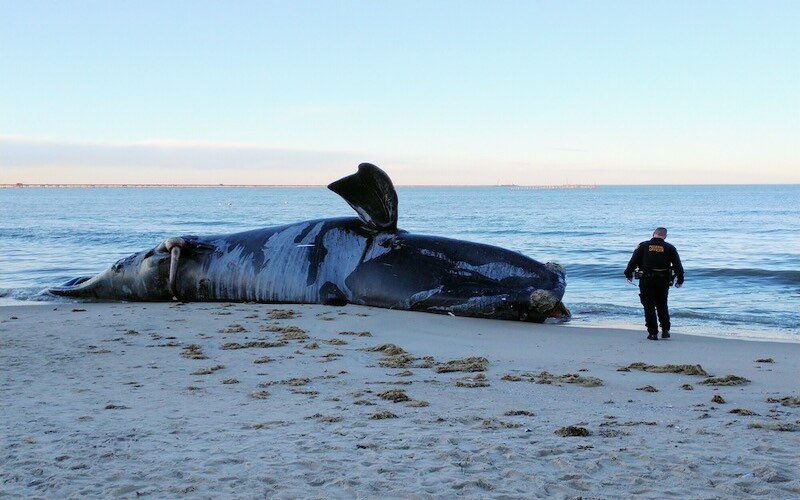
Vessel strike killed a North Atlantic right whale. Photo: Center for Biological Diversity
VIRGINIA BEACH, VA — A North Atlantic right whale that washed up dead on the shore Sunday was likely killed by a vessel collision, NOAA Fisheries announced today. The results of a necropsy determined the cause of death to be “blunt force trauma,” which indicates the animal was struck by a passing vessel.
“Since 2017, at least 95 critically endangered right whales have been killed or injured by preventable human causes,” said Erica Fuller at Conservation Law Foundation. “Yet nothing has been done to reduce deadly vessel strikes. Right whales have been on this planet for millions of years and we are at risk of losing this entire species because of bureaucratic red tape. That cannot be allowed to continue.”
The whale, a 20-year-old male, was found near the entrance to a port, although it is unclear where he was when he was hit. The port area has a 10-knot speed restriction in place, but the current speed rule extends only 20 miles from the port entrance, and military vessels and vessels under 65 feet in length are exempt from the restriction.
“Ongoing delays in improving protections are the reason we are losing right whales,” said Regina Asmutis-Silvia, executive director of Whale and Dolphin Conservation. “Just like the promise of food isn’t going to keep you from starving, these whales can’t survive on the hope of future actions. They need protections now.”
“This whale’s death is a tragic reminder of the constant danger North Atlantic right whales are facing,” said Kristen Monsell, oceans legal director at the Center for Biological Diversity. “Right whales desperately and immediately need more protections from vessel strikes and all the other human-caused threats they encounter. Otherwise this species is likely to go extinct.”
In November 2022 conservation groups filed an emergency rulemaking petition with NOAA Fisheries to protect North Atlantic right whales from being struck and killed by vessels in their calving grounds off the coast of the southeast United States. On January 20 the agency denied the groups’ request for emergency action, stating that it intends to enhance the rule this coming year.
Vessel strikes are one of two primary threats to the species’ existence, along with entanglements in commercial fishing gear. Right whales begin giving birth to calves around mid-November and the season lasts until mid-April. Both females and calves in southeastern waters are especially vulnerable during that time.
“This right whale’s violent death by vessel-caused blunt force trauma underscores that humans are responsible for all these preventable deaths,” said Jane Davenport, senior attorney at Defenders of Wildlife. “There’s still time to save this species by expanding proven commonsense measures like seasonal vessel speed limits, but the extinction clock speeds up every time we kill another whale.”
With a declining population of 340 individuals and only 70 breeding females, the North Atlantic right whale will almost certainly go extinct without key conservation measures. Current regulations are not sufficient to protect the whales, and changes proposed by NOAA Fisheries last August are unlikely to go into effect before the end of this year’s calving season.
Experts are available for further comment.
###
